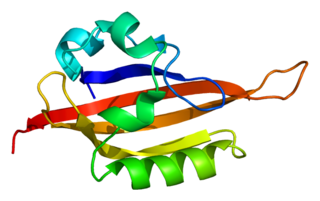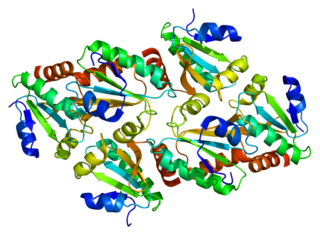Protein OS-9 is a protein that in humans is encoded by the OS9 gene. [5] [6] [7] [8] [9]
Protein OS-9 is a protein that in humans is encoded by the OS9 gene. [5] [6] [7] [8] [9]
This gene encodes a protein that is highly expressed in osteosarcomas. This protein binds to the hypoxia-inducible factor 1 (HIF-1), a key regulator of the hypoxic response and angiogenesis, and promotes the degradation of one of its subunits. Alternate transcriptional splice variants, encoding different isoforms, have been characterized. [9]

SMAD family member 6, also known as SMAD6, is a protein that in humans is encoded by the SMAD6 gene.

Hypoxia-inducible factor 1-alpha, also known as HIF-1-alpha, is a subunit of a heterodimeric transcription factor hypoxia-inducible factor 1 (HIF-1) that is encoded by the HIF1A gene. The Nobel Prize in Physiology or Medicine 2019 was awarded for the discovery of HIF.

DNA replication licensing factor MCM7 is a protein that in humans is encoded by the MCM7 gene.

DNA replication licensing factor MCM2 is a protein that in humans is encoded by the MCM2 gene.

DNA replication licensing factor MCM3 is a protein that in humans is encoded by the MCM3 gene.

Calcium/calmodulin-dependent protein kinase type IV is an enzyme that in humans is encoded by the CAMK4 gene.

Endothelial PAS domain-containing protein 1 is a protein that is encoded by the EPAS1 gene in mammals. It is a type of hypoxia-inducible factor, a group of transcription factors involved in the physiological response to oxygen concentration. The gene is active under hypoxic conditions. It is also important in the development of the heart, and for maintaining the catecholamine balance required for protection of the heart. Mutation often leads to neuroendocrine tumors.

Hypoxia-inducible factor 3 alpha is a protein that in humans is encoded by the HIF3A gene.

Chemokine-binding protein 2 is a protein that in humans is encoded by the CCBP2 gene.

Heat shock 70 kDa protein 4 is a protein that in humans is encoded by the HSPA4 gene.

Hypoxia-inducible factor prolyl hydroxylase 2 (HIF-PH2), or prolyl hydroxylase domain-containing protein 2 (PHD2), is an enzyme encoded by the EGLN1 gene. It is also known as Egl nine homolog 1. PHD2 is a α-ketoglutarate/2-oxoglutarate-dependent hydroxylase, a superfamily non-haem iron-containing proteins. In humans, PHD2 is one of the three isoforms of hypoxia-inducible factor-proline dioxygenase, which is also known as HIF prolyl-hydroxylase.

DnaJ homolog subfamily A member 1 is a protein that in humans is encoded by the DNAJA1 gene.

Chemokine ligand 3-like 1, also known as CCL3L1, is a protein which in humans is encoded by the CCL3L1 gene.

Egl nine homolog 3 is a protein that in humans is encoded by the EGLN3 gene. ELGN3 is a member of the superfamily of alpha-ketoglutarate-dependent hydroxylases, which are non-haem iron-containing proteins.

Necdin is a protein that in humans is encoded by the NDN gene.

Eukaryotic translation initiation factor 3 subunit H (eIF3h) is a protein that in humans is encoded by the EIF3H gene.

Beta-1,4-mannosyl-glycoprotein 4-beta-N-acetylglucosaminyltransferase is an enzyme that in humans is encoded by the MGAT3 gene.

ATP-binding cassette sub-family B member 9 is a protein that in humans is encoded by the ABCB9 gene.

Thioredoxin, mitochondrial also known as thioredoxin-2 is a protein that in humans is encoded by the TXN2 gene on chromosome 22. This nuclear gene encodes a mitochondrial member of the thioredoxin family, a group of small multifunctional redox-active proteins. The encoded protein may play important roles in the regulation of the mitochondrial membrane potential and in protection against oxidant-induced apoptosis.

Diamine acetyltransferase 2 is an enzyme that in humans is encoded by the SAT2 gene. SAT2 maintains a key metabolic glutamine/glutamate balance underpinning retrograde signaling by dendritic release of the neurotransmitter glutamate.